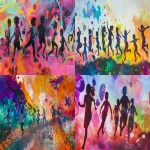Explore the Best AI Image Gallery

AI Images in Marketing: Transforming the Creative Landscape
The integration of artificial intelligence (AI) into various domains has ushered in unprecedented changes, particularly in marketing. AI-generated images stand at the forefront of this transformation, offering brands innovative ways to engage with their audiences. As technology continues to evolve, understanding its impact on the creative industry, potential uses, ethical considerations, and future trends becomes essential for marketers and creators alike.
The Impact on the Creative Industry
AI images are reshaping the creative industry by automating processes and enhancing creative potential. Traditionally, creating high-quality visuals required considerable time, skill, and resources. AI tools now enable marketers to generate compelling images quickly and efficiently. This democratization of image creation lowers entry barriers for smaller brands and independent creators, allowing them to compete with established players.
Moreover, AI-generated visuals assist in personalizing marketing campaigns. Brands can develop tailored content that resonates more deeply with specific audience segments. For instance, AI algorithms analyze customer preferences and behavior, allowing marketers to create images that reflect the target demographic's desires and tendencies. This level of customization significantly enhances engagement rates and leads to higher conversion rates.
Potential Uses of AI-Generated Images
The potential applications of AI-generated images in marketing are vast. Here are some notable uses:
- Social Media Content: Brands leverage AI tools to produce eye-catching visuals for social media platforms. Engaging graphics can attract more followers and improve shares and likes, enhancing overall brand visibility.
- Advertising Campaigns: AI can automate the creation of multiple ad variations, each tailored to different audience profiles. This adaptability allows brands to optimize their campaigns in real-time, increasing effectiveness.
- Product Visualization: Retailers can utilize AI to create striking product images. Virtual representations, such as lifestyle shots and 360-degree views, provide consumers with a better understanding of products before purchase.
- Brand Storytelling: AI can craft narratives through visual content, helping brands express their values and connect emotionally with their audience. Storytelling is crucial in modern marketing, and AI eases this process through compelling imagery.
Ethical Considerations
Despite the numerous advantages AI-generated images offer, ethical considerations must be addressed. One primary concern is the authenticity of visual content. With AI's ability to create hyper-realistic images, it becomes challenging for consumers to discern what is real and what is artificially generated. This ambiguity can lead to trust issues between brands and their audiences.
Moreover, the use of AI in marketing raises questions about copyright and ownership. Who owns an image created by an AI algorithm? This question is particularly pertinent when brands use AI tools that have been trained on vast datasets, including copyrighted material. As AI technology advances, legal frameworks will need to adapt to address these new challenges.
Another ethical dilemma revolves around bias in AI-generated content. If the training data contains biased or discriminatory elements, the AI may produce images that reflect these biases, further perpetuating stereotypes and limiting diversity in marketing visuals.
Future Trends in AI Images and Marketing
The future of AI-generated images in marketing holds great promise. One trend to watch is the rise of augmented reality (AR) and virtual reality (VR) experiences driven by AI-generated visuals. By incorporating immersive effects and interactive elements, brands can create memorable campaigns that engage consumers on a deeper level.
In addition, as machine learning algorithms advance, the quality and customization of AI-generated images will improve. Marketers will increasingly rely on AI to create sophisticated visuals that adapt to real-time data, delivering content that is not only visually appealing but also contextually relevant.
Furthermore, the growing emphasis on sustainability in marketing may influence the adoption of AI-generated images. Digital content reduces reliance on physical materials, aligning with eco-friendly practices. Brands that prioritize sustainability may find AI-generated visuals as a powerful ally in achieving their goals.
Conclusion
AI-generated images are revolutionizing the marketing landscape, offering innovative solutions that enhance creativity and engage audiences. However, as with any advancement, ethical considerations should not be overlooked. As marketers embrace this technology, it is crucial to navigate the challenges it presents while harnessing its full potential for innovation.
](https://images.ai-img.art/thumbnails/150/47d44e177f427ea6b32f96ea225db96c5158850a0cf01d1bad93e45dd4594430.webp)







](https://images.ai-img.art/thumbnails/150/c48401bc3fad7ff7f2dbd37b894d3f53cb42d5072dfacb8bfdcdeeef28a29b04.webp)

](https://images.ai-img.art/thumbnails/150/09ccae5e68e2b6da6b5da87ef69f7eb09e80c99ca39ba886c5c3773cbb3b89ba.webp)



](https://images.ai-img.art/thumbnails/150/44b76c49c47b4c47f13eac7883c63827d3f89aa77fe64ce0cbecb9d3ce434499.webp)





























](https://images.ai-img.art/thumbnails/150/c2241c1eabdcb7b9a98be19a7e8d850b6cffe0e0c91c1ccda8dd807e2a96b187.webp)




